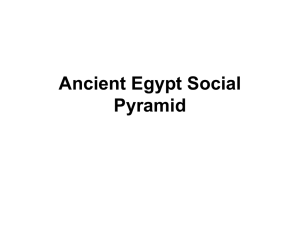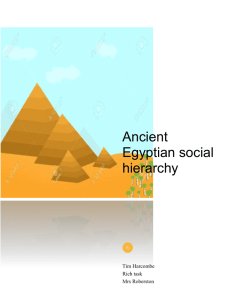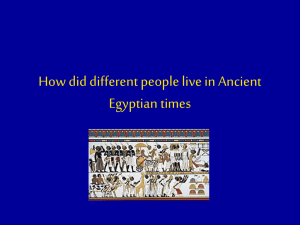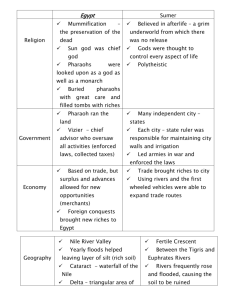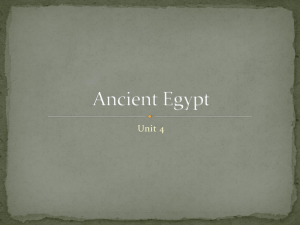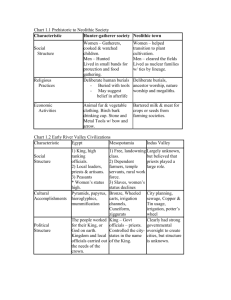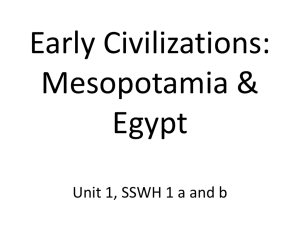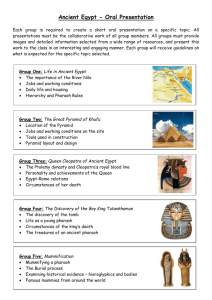Daily Life in Egypt*s Social Classes
advertisement
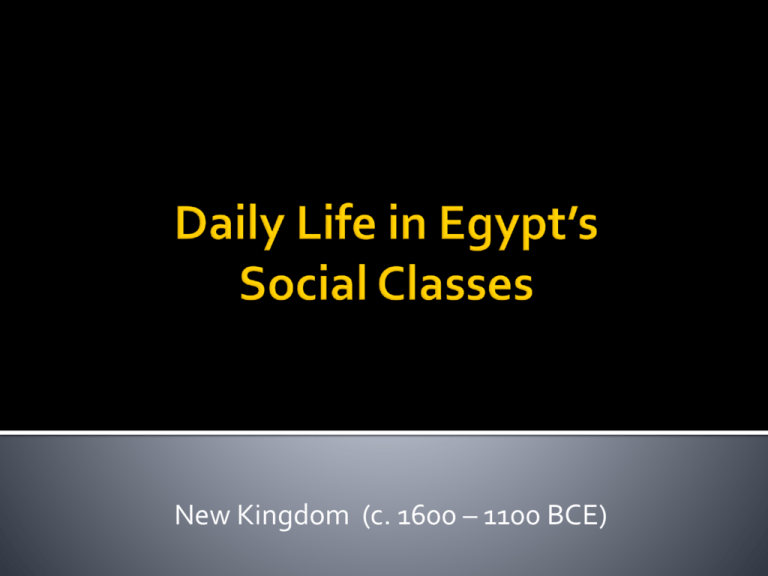
New Kingdom (c. 1600 – 1100 BCE) 1. Introduction 2. Social Class - a group of people in society who have the same economic, cultural, and political status 2. Social Pyramid: describes the system of social class where high status classes have fewer members than low status classes 1. Ancient Egypt’s Social Pyramid 2. Government Officials – carried out Pharaoh’s wishes, powerful and wealthy 2. Priests – controlled temples and religious rituals 2. Scribes – respected because they could write and were important for government and business 2. Artisans – highly skilled craftspeople and artists 2. Peasants – largest class (but lowest status); worked the land and helped on pharaohs’ projects 2. Life in Egypt’s social classes 3. Fairly rigid (unchanging)—most people stayed in the class they were born in 3. Common things between classes: 4. Family life was important 4. Men were head of household, women managed the home and raised children 4. Women had more freedom and rights than most women elsewhere at the time 5. Could own land, run businesses, represent themselves in legal matters, work as government officials or priestesses 4. Quality of life was better higher on the pyramid 4. Egyptians believed this system created a stable society 1. Government Officials 2. Highest social class (after the pharaoh) 2. Assisted the pharaoh in ruling the country 2. Important officials: 3. Vizier – high-ranking official, advisor to pharaoh 4. Appointed other officials 4. Was the head judge of Egypt 3. Chief treasurer – controlled taxes and maintained wealth of the empire 3. General of the Armies – top military commander (after the pharaoh) 2. Lives of Luxury 3. Government officials had plenty of money and free time 3. Often held fancy banquets with many guests and fine food 1. Priests 2. Second highest class, very powerful and well respected 2. Different jobs for Priests 3. High Priest – advised the pharaoh, ran religious ceremonies 3. Temple priests – took care of the god that lived in the statue within each temple’s sanctuary 3. Other priests - gave advice, handled healing etc. 2. Priests’ Role in Burial Practices 3. Oversaw embalming (preparation for the afterlife) 1. Scribes 2. Third highest class, respected and well paid 2. Official writers and record keepers of Egypt 2. Men from any social class could become scribes (rare in the rigid class system) 2. Scribe schools 3. Started around age 5 3. Lasted 12 years 3. Students had to memorize over 700 Hieroglyphs (symbols representing words and sounds) 2. The work of scribes: 3. Recorded grain and food supply 3. Wrote the census – official count of the population 3. Many other jobs (recording taxes, legal rulings, military matters) 2. Tools: 3. Finely sharpened reeds as pens 3. Papyrus to write on 3. Writing tablet to support papyrus (made of wood or stone) 1. Artisans 2. Craftspeople and artists 2. Closest to what we would call the “Middle Class” 2. Highly skilled, yet not well respected (often taken for granted) 2. Many specializations (carpentry, jewelry, painting, sculpting etc) 2. Stone carvers were very highly skilled and worked hard to make sculptures for wealthy Egyptians 2. Daily Life of Artisans 3. Lived in modest homes with about three rooms 3. Worked side by side in large workshops 3. Sometimes worked with hundreds of others on big projects 3. Usually didn’t receive recognition for their work 1. Peasants 2. Lowest class and by far the largest 2. Produced the stable food supply that made Egyptian civilization possible 2. Three seasons of the Nile: 3. Flooding season – June to September 4. Farmers worked on other projects (like pyramids) 3. Planting season – October to March 3. Harvest season – March – May 4. Busiest time of the year 4. People often worked from dawn to dusk 2. Daily life of peasants 3. Simple houses, little furniture 3. Food was simple, rarely included meat (in times of famine, sometimes they only had papyrus to eat) 3. Worked most of the time but had games for fun and celebrated several important holidays
